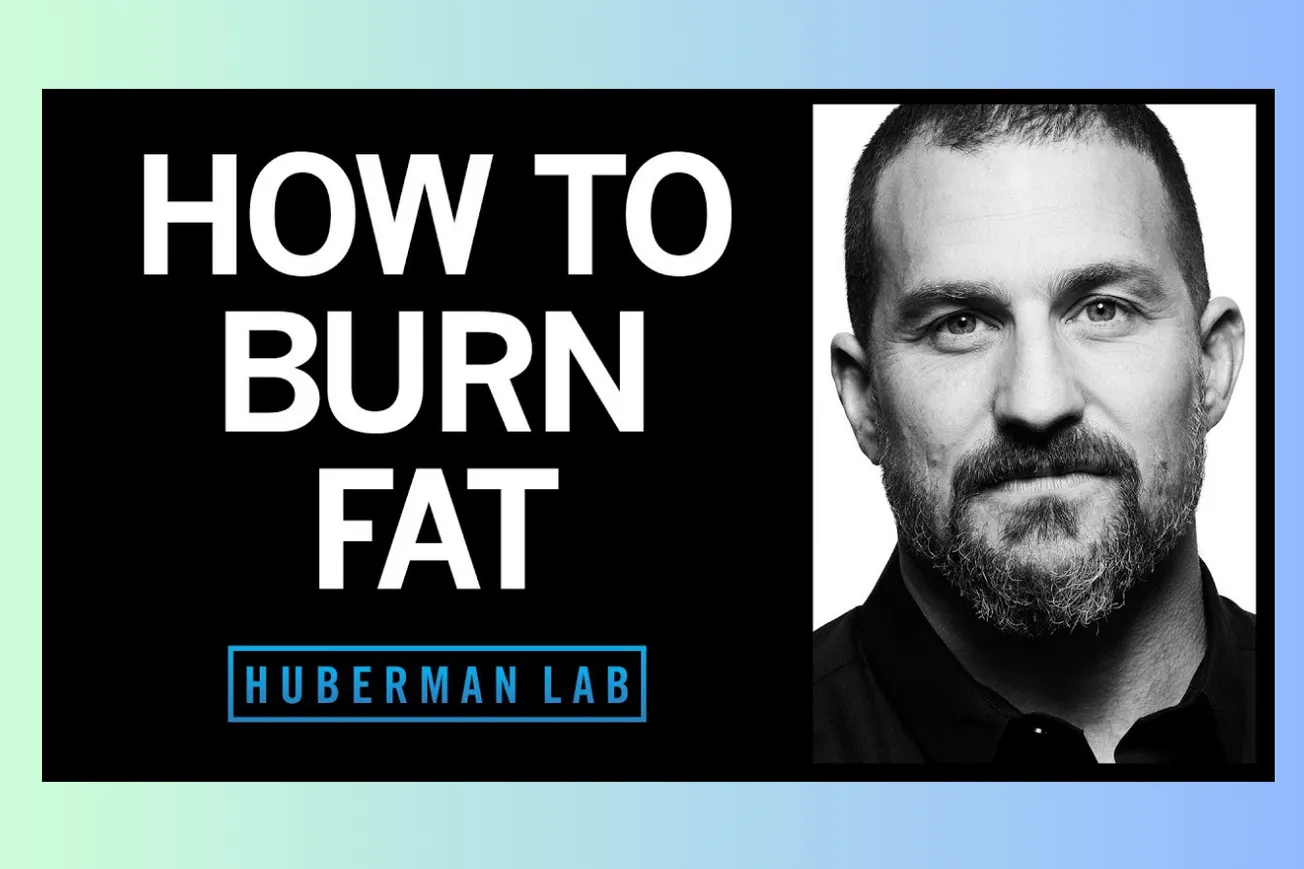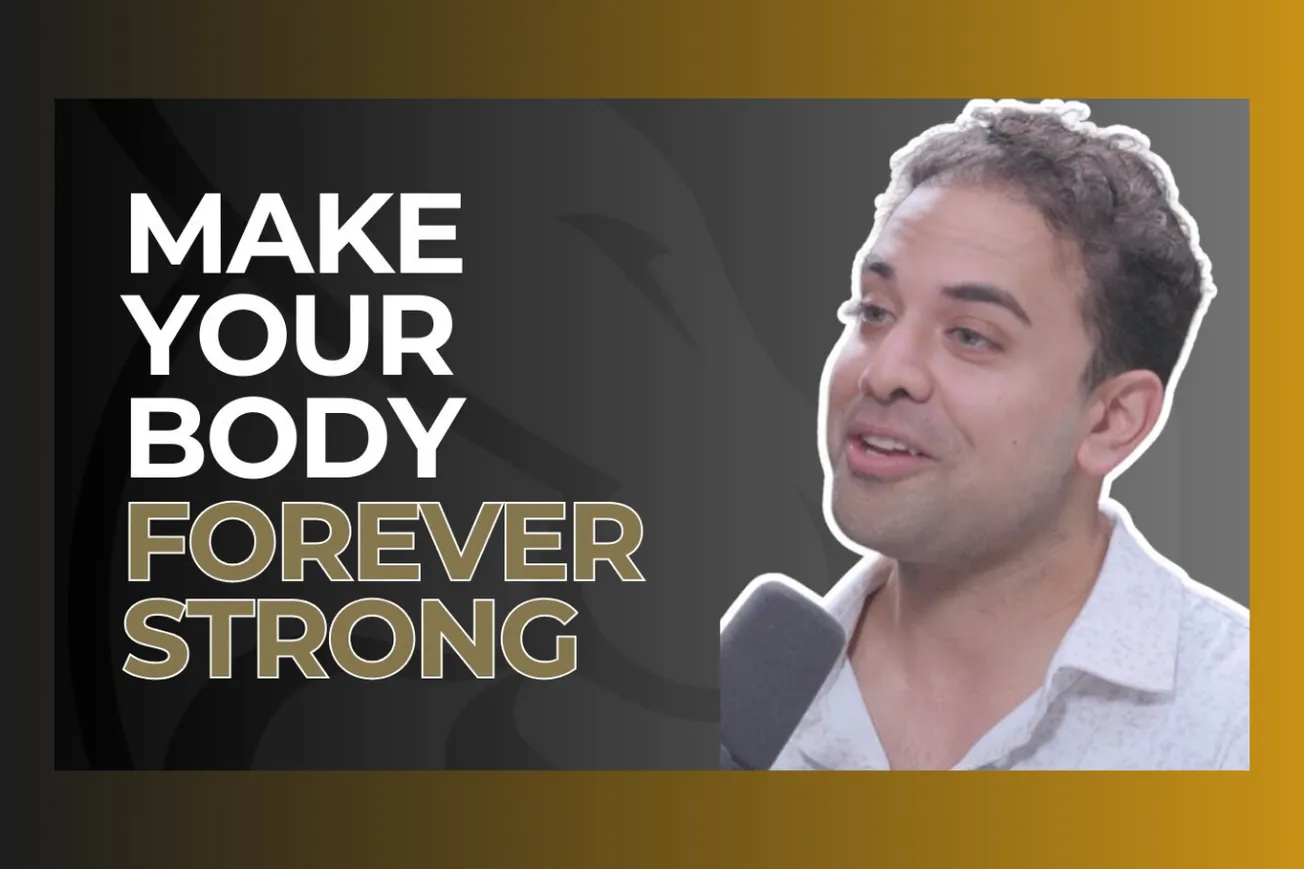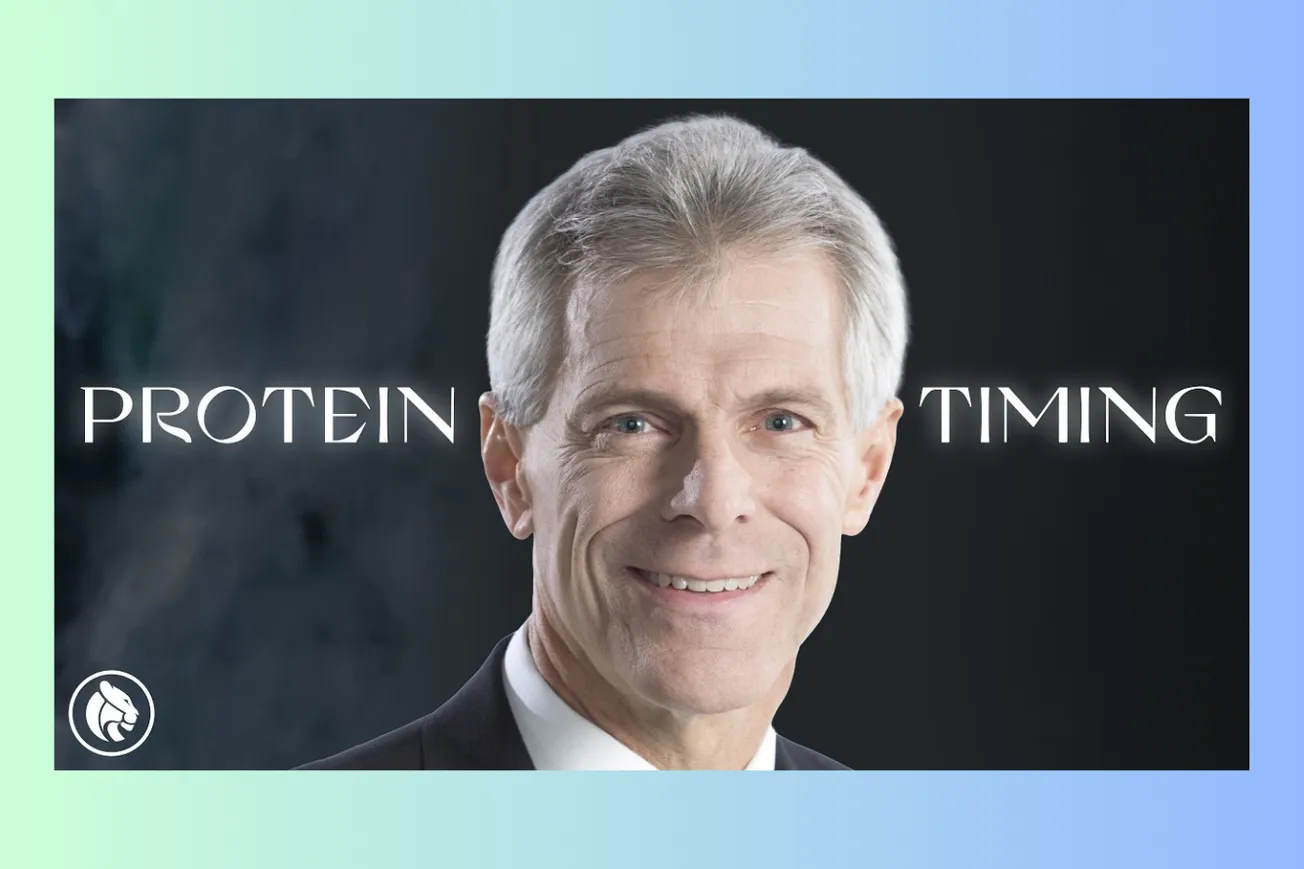Table of Contents
Unlock the secrets to effective fat loss using science-based tools discussed by Andrew Huberman. Discover how your nervous system, specific movements, cold exposure, and targeted supplementation can significantly enhance your body's ability to burn fat beyond the simple calories-in, calories-out equation.
Timeline Overview
- 00:00 - 15:00 — Introduction to the podcast's goal of providing science-based tools. Discussion of sponsors (InsideTracker, ExpressVPN, Athletic Greens) and the importance of foundational health markers like sleep, essential fatty acids (aiming for >1000mg EPA daily), gut health (probiotics/fermented foods), and thyroid support (iodine, selenium via Brazil nuts). Introduction to the topic: the nervous system's overlooked role in fat loss, moving beyond just "calories in vs. calories out."
- 15:00 - 30:00 — The critical role of belief and mindset in physiological outcomes, referencing Alia Crum's study on hotel workers showing that belief in exercise benefits enhanced actual fat loss. Introduction to the two key steps of fat utilization: mobilization (lipolysis - breaking fat out of cells) and oxidation (burning fat for energy in mitochondria). Emphasis that just mobilizing fat isn't enough; it must be oxidized or it can be stored again. The nervous system, specifically neurons releasing epinephrine (adrenaline) locally onto fat cells, controls both steps, debunking the myth that only systemic adrenaline matters.
- 30:00 - 45:00 — Exploration of Non-Exercise Activity Thermogenesis (NEAT), pioneered by Rothwell and Stock. Discovery that "fidgeters" (people who make many small, subtle movements like knee bouncing, pacing, quick gestures) burn significantly more calories (800-2500 extra per day) than non-fidgeters, even when overeating. This isn't about traditional exercise calorie burn; these small movements trigger local epinephrine release, boosting fat mobilization and oxidation. Protocol suggestion: consciously incorporate more fidgeting, pacing, and quick movements throughout the day.
- 45:00 - 1:00:00 — Shivering as a powerful stimulus for fat loss, also mediated by epinephrine release and muscle activity. Introduction of white, brown (BAT), and beige adipose tissue. Brown fat, rich in mitochondria and located mainly between shoulder blades/neck, acts like a furnace. Cold exposure activates BAT and can convert beige fat to brown fat. Shivering, triggered by cold, releases succinate from muscles, which acts on BAT to increase thermogenesis and fat burning. Crucial point: resisting the shiver short-circuits this benefit. Protocol: Use cold exposure (shower, plunge, etc.) 1-5 times/week, aiming for the minimal cold needed to induce shivering. Repeatedly get in and out (e.g., 3 rounds of 1-3 mins in, 1-3 mins out without drying) maximizes shiver and succinate release, avoiding rapid cold adaptation which dampens the effect. Mention of irisin's previously hyped role, now largely superseded by succinate science. Discussion of babies having abundant brown fat because they can't shiver.
- 1:00:00 - 1:15:00 — Discussion on the potential for spot reduction, previously considered a myth. Since fat mobilization is controlled by local nerve endings releasing epinephrine, targeted activation might theoretically allow for localized fat loss. Suggestion that novel exercise patterns engaging different body parts might help access "stubborn" fat pads by stimulating underused neural pathways. Transition to traditional exercise types: High-Intensity Interval Training (HIIT), Sprint Interval Training (SIT), and Moderate Intensity Continuous Training (MICT), defined by VO2 max percentages and durations.
- 1:15:00 - 1:30:00 — Analyzing fasted vs. fed exercise for fat loss. While insulin inhibits fat oxidation, studies show minimal difference for shorter exercise bouts. However, for moderate intensity exercise longer than 90 minutes, training fasted significantly increases fat burning from the 90-minute mark onward because glycogen stores deplete, forcing a switch to fat reserves. High-intensity exercise (weights, sprints) depletes glycogen faster, meaning the switch to enhanced fat burning occurs earlier if fasted. Discussion of the post-exercise effect (EPOC): high-intensity exercise burns more glycogen during but more fat afterwards, while moderate/low intensity burns more fat during but more glycogen afterwards. Optimal strategy for fat loss appears to be higher intensity training (potentially followed by low intensity), especially when fasted, due to greater overall metabolic increase and post-exercise fat burn.
- 1:30:00 - 1:45:00 — Exploring compounds that enhance fat mobilization and oxidation via the epinephrine pathway. Caffeine (100-400mg, 30-40 mins pre-exercise for adapted individuals) increases epinephrine and fat oxidation. Mention of historical, dangerous compounds like ephedrine and Fen-Phen. Introduction of the GLP-1 pathway (glucagon-like peptide-1), which facilitates fat oxidation. Yerba Mate and Guayusa tea naturally increase GLP-1. Drinking mate before exercise enhances fat burning; sipping throughout the day also helps. Reusing mate leaves can extract more GLP-1-boosting compounds. Mention of pharmaceutical GLP-1 analogs (like Semaglutide) used for diabetes/obesity but require prescription. Brief mention of insulin-lowering compounds like Berberine/Metformin aiding fat oxidation indirectly.
- 1:45:00 - End — Discussing L-carnitine (specifically acetyl-L-carnitine) which facilitates the actual fat oxidation step within the mitochondria (transporting fatty acids). Supplementing with 500mg to 2g daily (divided doses) can enhance fat loss. Mention of other potential benefits: reducing blood ammonia, C-reactive protein, improving sperm quality/motility, slight blood pressure reduction, reducing exercise fatigue. Recap of key tools: NEAT (fidgeting), cold exposure (inducing shiver), exercise timing/intensity (higher intensity, potentially fasted), caffeine, mate/guayusa (GLP-1), L-carnitine. Final remarks and podcast support information.
Key Takeaways
- Your nervous system directly controls fat burning through neurons that release epinephrine (adrenaline) onto fat cells, impacting both mobilization and oxidation.
- Non-Exercise Activity Thermogenesis (NEAT), or simple fidgeting and subtle movements throughout the day, can burn an extra 800-2500 calories daily by stimulating local fat burning.
- Shivering from cold exposure is highly effective for fat loss; it triggers muscle to release succinate, activating brown fat's furnace-like properties. Don't resist the shiver for this benefit.
- Repeatedly entering and exiting cold (e.g., 3 rounds of 1-3 mins in/out) maximizes shiver and metabolic boost, more so than prolonged cold adaptation.
- High-intensity exercise burns more glycogen during activity but significantly elevates fat burning after the workout (EPOC) compared to steady-state cardio.
- Training fasted enhances fat burning, especially for moderate exercise lasting over 90 minutes or when combining high-intensity work with subsequent lower-intensity activity.
- Yerba Mate and Guayusa tea increase GLP-1, a hormone that promotes fat oxidation, particularly effective when consumed before exercise.
- Acetyl-L-carnitine aids the fat oxidation process within cells, helping convert mobilized fatty acids into usable energy (ATP).
The Nervous System's Role in Fat Loss
- Fat loss fundamentally involves two steps: mobilizing fat from storage (lipolysis) and then burning that fat for energy (oxidation) within cells, primarily in mitochondria.
- Contrary to common belief focusing only on systemic hormones, local nerve endings directly attached to fat tissue release epinephrine (adrenaline) to initiate both mobilization and oxidation. This neural control is crucial.
- The amount and pattern of this neural stimulation significantly impact the "calories burned" side of the energy balance equation, offering leverage points beyond just diet and exercise volume.
- Understanding this neural connection opens possibilities for targeted fat loss strategies, potentially even spot reduction in the future, by selectively activating nerves innervating specific fat pads.
Harnessing NEAT: Burn Calories Without "Exercise"
- Non-Exercise Activity Thermogenesis (NEAT) refers to the calories burned from everyday movements not classified as formal exercise, like fidgeting, pacing, maintaining posture, or even brief walks.
- Studies by Rothwell and Stock revealed that individuals who naturally fidget more (e.g., bouncing knees, tapping fingers, frequent posture shifts) burn substantially more calories daily (800-2500) than sedentary individuals.
- These subtle, often unconscious movements trigger the release of epinephrine from nerve endings onto fat cells, promoting both fat mobilization and subsequent oxidation, contributing significantly to overall energy expenditure.
- Consciously increasing NEAT by pacing during calls, standing up more frequently, choosing stairs, or even deliberately fidgeting can be a powerful, low-impact tool to boost daily caloric burn and aid fat loss efforts. Andrew Huberman notes, "people that stand up and sit down a lot throughout the day, and people that pace burn anywhere from 800 to 2,500 calories more."
Cold Exposure and Shivering for Fat Metabolism
- Exposure to cold stimulates fat loss through multiple mechanisms involving the nervous system and different types of fat (white, brown, beige).
- Shivering, the body's rapid muscle contraction response to cold, is a key trigger. It causes muscles to release succinate, a molecule that activates brown adipose tissue (BAT).
- Brown fat acts like a metabolic furnace, burning energy to generate heat directly. Activating it increases your overall metabolic rate. Cold exposure can also help convert less active 'beige' fat into more metabolically active brown fat over time.
- For fat loss, the goal isn't prolonged cold endurance but inducing shiver. Repeated short exposures (e.g., 3 cycles of 1-3 minutes in cold, 1-3 minutes out) are more effective than staying in until adapted, as adaptation reduces the shiver response and succinate release. Huberman states, "if you resist the shiver, you are not going to get the increased metabolic effect, because you are not going to get the succinate release."
- Find a cold temperature (cold shower, plunge) that reliably makes you shiver within a minute or so; it doesn't need to be painfully cold, just enough to trigger the response.
Optimizing Exercise for Fat Loss
- Different exercise intensities tap into different fuel sources and have distinct post-exercise effects. High-intensity training (weights, sprints, HIIT) primarily uses glycogen (stored carbohydrates) during the workout.
- However, this high-intensity work leads to a greater "afterburn" effect, known as Excess Post-exercise Oxygen Consumption (EPOC), where the body burns significantly more fat in the hours following the workout to recover.
- Moderate or low-intensity steady-state exercise (like jogging or cycling) burns a higher percentage of fat during the activity itself, especially after the 90-minute mark when glycogen stores run lower.
- After moderate/low intensity exercise, the body tends to burn more glycogen during recovery, the opposite of the high-intensity afterburn.
- Training in a fasted state (not eating for 3+ hours prior) enhances fat burning during exercise, particularly for sessions longer than 90 minutes or when combining high-intensity efforts with subsequent lower-intensity work, as insulin levels are lower, facilitating fat mobilization and oxidation. A strategy could be: "exercise intensely for 20 to 60 minutes... and then move over into Zone 2 cardio."
- Engaging in novel or varied exercise routines might help stimulate nerve pathways connected to "stubborn" fat areas that have become accustomed to regular movement patterns.
Supplements to Support Fat Loss Efforts
- Caffeine: Can increase fat mobilization and oxidation by boosting epinephrine release. Effective dosages are typically 100-400mg taken 30-40 minutes before exercise, but only if you are caffeine-adapted; non-adapted individuals may experience vasoconstriction, hindering performance.
- Yerba Mate / Guayusa: These teas contain compounds that increase GLP-1, a hormone promoting fat oxidation and potentially reducing appetite. Drinking before exercise appears particularly beneficial for enhancing fat burn. They offer a milder stimulant effect than coffee for many.
- Acetyl-L-Carnitine: This compound plays a crucial role in transporting fatty acids into the mitochondria to be burned for energy (oxidation). Supplementing (500mg - 2g daily) may directly enhance this fat-burning step, especially if dietary intake is low.
- Foundationals: Ensure adequate intake of essential fatty acids (especially >1000mg EPA daily), support gut health (fermented foods), and ensure sufficient iodine and selenium (e.g., 1-3 Brazil nuts daily) for proper thyroid function, which underpins overall metabolism.
Mindset and Foundational Health
- The belief that your activities are beneficial for health can significantly impact physiological outcomes, including fat loss, as demonstrated by research from Alia Crum. Cultivating a positive mindset towards your efforts is important.
- Prioritize foundational health elements before focusing heavily on specific fat loss protocols. This includes getting sufficient quality sleep, managing light exposure, ensuring adequate intake of essential fatty acids (aiming for >1000mg EPA daily), supporting gut health with fermented foods, and maintaining proper thyroid function through sufficient iodine and selenium (Brazil nuts are a great source).
- Address nutrient deficiencies that might drive cravings. For example, cravings for sugar can sometimes stem from the body needing essential fatty acids or amino acids (like glutamine); satisfying these underlying needs can reduce sugar cravings.
Bottom Line
Achieving sustainable fat loss involves more than just calorie counting; leveraging your nervous system through strategies like NEAT, controlled cold exposure to induce shiver, and optimized exercise timing can significantly enhance results. Supporting these behavioral tools with foundational health and potentially targeted supplements like caffeine, mate, or L-carnitine provides a comprehensive, science-backed approach.









